
Salix pentandra, the bay willow, is a species of willow native to northern Europe and northern Asia. The scientific name refers to the male flowers having five stamens. The English name derives from the resemblance of the leaves to those of the bay laurel; other common names include bay-leaved willow and laurel willow. Its glossy leaves make it more decorative than many other willows, so it is often planted as an ornamental tree.

Salix nigra, the black willow, is a species of willow native to eastern North America, from New Brunswick and southern Ontario west to Minnesota, and south to northern Florida and Texas.
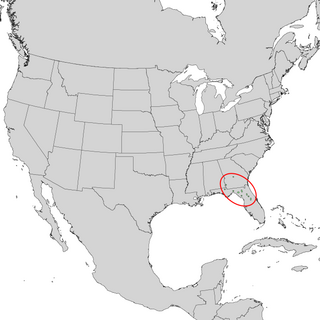
Salix floridana, the Florida willow, is a species of willow in the family Salicaceae. It is native to the southeastern United States in northern Florida and southwestern Georgia.

Salix triandra, with the common names almond willow, almond-leaved willow or black maul willow, is a species of willow native to Europe and Western and Central Asia. It is found from south-eastern England east to Lake Baikal, and south to Spain and the Mediterranean east to the Caucasus, and the Alborz Mountains. It usually grows in riparian habitats, on river and stream banks, and in wetlands.

Salix delnortensis is a species of willow known by the common name Del Norte willow.
Salix barrattiana is a species of flowering plant in the willow family known by the common name Barratt's willow. It is native to North America, where it is distributed across Alaska and western Canada, with also a few populations in Montana and Wyoming. These disjunct populations are probably relics from a time when the climate was colder. The southernmost population is technically in Wyoming, but it is located at the Montana state line and it is limited to one clone of all-staminate plants within an area of 100 square meters (1,100 sq ft) in a high-elevation habitat.
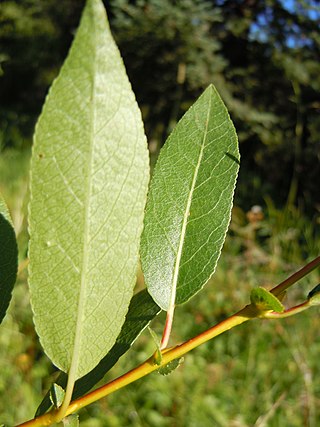
Salix boothii is a species of willow known by the common name Booth's willow.
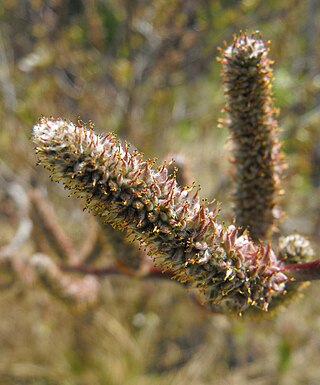
Salix breweri is a species of willow known by the common name Brewer's willow. It is endemic to California, where it can be found in the serpentine soils of the Coast Ranges in and around the San Francisco Bay Area. It is a riparian shrub growing one to four meters in height. The yellowish or reddish brown stems are lightly hairy in texture, the small twigs coated in velvety fibers. The leaves are generally lance-shaped, smooth-edged or gently toothed, and partially rolled under along the edges. The leaves are hairy, with the lower surfaces often quite woolly. Mature leaves may be 14 centimeters long or more. The inflorescence is a catkin which develops before the plant produces leaves. The catkins are up to 5 or 6 centimeters long, the female ones lengthening further as the fruits develop.

Salix drummondiana is a species of willow known by the common name Drummond's willow. It is native to western North America from Yukon and the Northwest Territories in the north to California and New Mexico in the south. It is a resident of moist mountain habitats, including forests, riverbanks, and floodplains.
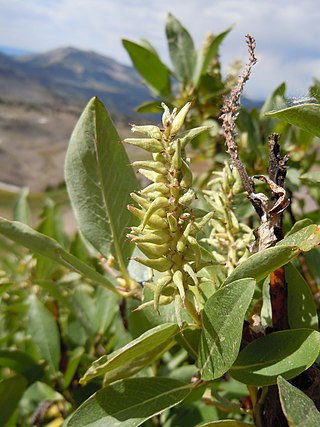
Salix eastwoodiae is a species of willow known by the common names mountain willow, Eastwood's willow, and Sierra willow. It was first described by Bebb in 1879 as Salix californica. This name was later found to be illegitimate, as Lesquereux had given the same name to a fossil willow in 1878.

Salix lemmonii is a species of willow known by the common name Lemmon's willow, named after J.G. Lemmon. It is native to western North America from British Columbia to California to Colorado, where it grows in moist and wet areas in mountain coniferous forest habitat, such as streambanks and meadows.

Salix melanopsis is a plant species known by the common name dusky willow. It is native to western North America from British Columbia and Alberta to California and Colorado, where it grows in many types of moist and wet habitat, such as riverbanks and subalpine mountain meadows, on rocky and silty substrates.
Salix orestera is a species of willow known by the common name Sierra willow, or gray-leafed Sierra willow. It is native to the Sierra Nevada of California and western Nevada, where it grows in moist areas in high mountain subalpine and alpine climates. It can also be found in Oregon.

Salix arbusculoides is a species of flowering plant in the willow family known by the common name little tree willow. It is native to northern North America, where its distribution extends across Alaska and most of Canada.
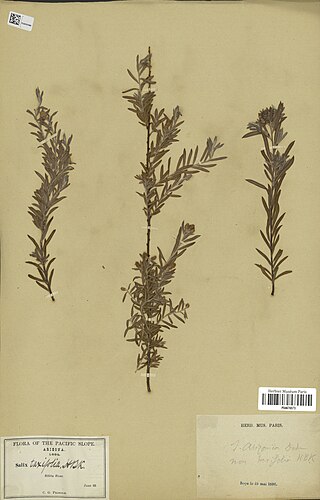
Salix arizonica is a species of willow known by the common name Arizona willow. It is native to the southwestern United States, where it occurs in Arizona, Colorado, New Mexico, and Utah.
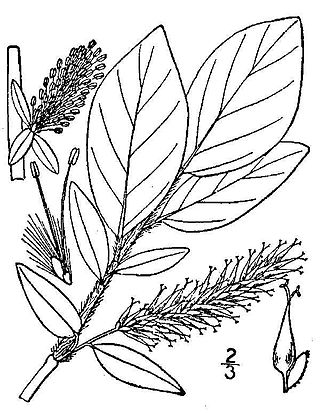
Salix barclayi, or Barclay's willow, is a species of willow native to North America, found primarily in the Northwestern area of the United States and Canada. It grows near lakes and streams at elevation. It is a shrub, that can grow up to 2.5 m. (8 ft.) tall and tends to be slender. Leaves are elliptic to obovate, 2–6 cm long and 1–2.5 cm wide. Leaves are hairy when young, with midrib hairs lasting into maturity. Catkins are on short, leafy peduncles. Staminate catkins are 3 cm long with 2 stamens, while pistillate catkins are 2.5–5 cm long and glabrous.

Salix eleagnos the bitter willow, olive willow, hoary willow, rosemary willow, or elaeagnus willow, is a species of flowering plant in the family Salicaceae, native to central and southern Europe and south west Asia. Growing to 3 m (10 ft) tall by 5 m (16 ft) broad, it is an erect bushy deciduous shrub with narrow grey-green leaves up to 20 cm (8 in) long, which turn yellow in autumn (fall). The green catkins, 3–6 cm (1–2 in) long, appear with the leaves in spring, male catkins having yellow anthers.
Salix delavayana is a shrub or small tree from the genus willow (Salix) with mostly 3 to 8 centimeters long leaf blades. The natural range of the species is in the south of China and in Tibet.
Salix erioclada is a species from the genus of willows (Salix) and grows as a shrub or small tree. The leaf blades have a length of about 5 centimeters. The natural range of the species is in China.
Salix ernestii is a species in the genus of willow (Salix) and grows as a shrub. The leaf blades are about 11 centimeters long. The natural range of the species is in China.














